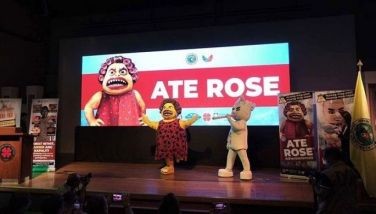EDITORIAL In the beginning, there was Lav
MANILA, Philippines - It was past two in the morning. In Venice, it was past seven in the evening.
I was in a hip bar in Makati, had already downed several shots of whatever cocktail was being served, and was beside a very lovely girl who I was slowly but surely trying to acclimate to the world of cinema that is beyond romance and superheroes. Amidst the ’90s pop songs that the DJ decided to play for the ecstatic partygoers who were probably less than a decade old when those songs became hits, I was whispering to both myself and the girl something that was totally disconnected to the brash display of youthful abandon that I had only recently started to enjoy.
“I hope Lav wins. I hope Lav wins. I am going to cry if Lav wins.”

A throwback to Lav Diaz’s Supreme cover in 2014, where he discussed everything — from his childhood to his beginnings as a filmmaker and the theory behind his cinema.
Minutes later, I received a phone call. It was Richard Bolisay, a dear comrade who, despite our many disagreements when it comes to films, had always shared a love for Lav. I walked outside the bar and started to get a blow-by-blow account of what was happening in Venice. Richard was at home and was watching the awarding ceremonies through the wonders of Internet live streaming. In between expletives, I was half-drunkenly talking about how I could never afford a suit designed by Tom Ford, whose sophomore directorial work also debuted at the film festival to critical acclaim. Then it happened. Lav won the Golden Lion, the same prize that has been won by legends like Akira Kurosawa, Andrei Tarkovsky and Jean-Luc Godard. It was one of the highest honors a Filipino film could ever achieve, and Lav’s Ang Babaeng Humayo, a black and white film that clocks in at close to four hours and whose budget is probably a minuscule fraction of what Ford needed to mount his second film, had just won.

Ang Babaeng Humayo bagged the award for Best Film at the 73rd Venice Film Festival.
Further excited bombardments of expletives were exchanged, then we said our respective thank yous and goodbyes. I went back inside the bar. Sat alone on a curiously empty bench. I looked around. Everybody was busy dancing, drinking and being happy. I was alone, sort of sobered by the beautiful news, my eyes welling with tears that I had to contain lest I ruin the mood of everybody YOLO-ing to the wee hours of the morning. She found me again; I told her that Lav had just won in Venice. I embraced her, or she embraced me. I don’t remember anymore, and it doesn’t matter. Love wins.
In the beginning, there was Lav.
My birth into Cinema
Well, not exactly. In the very beginning, there was Disney with its musical cartoons based on fairy tales, then blockbusters, Tolkien adaptations, Harry Potter, and all sorts of movies whose barometer for success is reliant on the money they have made. I watched a lot of other films as well, and got acquainted with directors like Wong Kar-Wai and Krzysztof Kieslowski, whose films opened me to that wonderful world outside Hollywood. However, I can say that I never understood the transformative power of cinema until that fateful day when I spent an entire day inside a cinema house.
The year was 2004 and the film was Ang Ebolusyon ng Isang Pamilyang Pilipino. The film, which painfully observes a poor farming clan from the early ’70s to the late ’80s, is close to 11 hours long, but during that screening in UP, the film lasted longer. Lav was transporting the screeners from his home in Cubao to the university, leaving rest periods ranging from 15 to 30 minutes between an hour of the film’s footage. I went inside the cinema in the morning, and left it at night, changed and rattled to the core. I had never seen or experienced anything like it before. I can still vividly remember the staggered ache of seeing Joel Torre clinging for his life, enduring a torturous march towards certain doom. I was horrified, shocked, but deeply moved. This wasn’t like any other film I’d seen. Lav didn’t want me to be in a state of comfort while he explored the ruin dealt by a nation’s sinful past. He wanted me to feel it, breathe it, and remember it.
I had to meet Lav.
A few months later, that opportunity arose. It was in Cubao, in one of the restaurants in the compound that used to house Marikina’s best shoes but after the invasion of cheaper imports, decided to rebrand itself as a den for artists and bohemians. Lav was with Raya Martin. We talked. I was in law school but was maintaining an obscure blog where I wrote about films. I was thrilled when Lav told me that he had read my writing. He insisted that I could do more, and talked about how the country needed film critics alongside filmmakers. He talked about Alexis Tioseco, who was then already traveling around the world spreading the movement that was happening in the Philippines, the same movement that had him fall in love with a cinema that he previously thought was all about slapstick and inane romances. I decided to take Lav’s advice with utmost seriousness, and from then on, started writing about films with an objective — an advocacy, if you will. It was that afternoon in the middle of Quezon City that would guide me in all the decisions I’ve made ever since, from championing new talents and ideas in the various screening committees I’ve been part of to my defense of Emerson Reyes’ right to make his first film his own way.
Lav, the Regal Baby
See, Lav hasn’t always been making films whose extreme running times are by themselves symbolic of the entire commercial system that has invaded the art. He was, once upon a time, a Regal baby. His first film, Serafin Geronimo: Kriminal ng Baryo Concepcion (1998), is a pito-pito flick, a low-budget project housed under Regal Films’ Golden Harvest brand. Perhaps because of its less-than-glamorous roots, Lav was able to flex his vision, creating a film that displayed with distinct clarity his affinity for Russian literature and his sincere concern for a nation that is tainted by a history of oppression. Burger Boys (1999), his next film, is a mystery. It is reportedly a bank robbery flick whose last existing copies are said to be lost. Hubad sa Ilalim ng Buwan (1999), with its provocative title, seems to fit within the wave of skin flicks that dominated the latter part of the ’90s, but in truth, the film, which starred Joel Torre and voluptuous Klaudia Koronel, was more interested in existential themes than the prurient spectacle of exposed skin. Hesus Rebolusyonaryo (2002) is perhaps Lav’s most interesting studio film. On paper, it reads like a run-of-the-mill sci-fi actioner, with Mark Anthony Fernandez, who was being groomed as the next action hero, playing the titular hero who needs to rid dystopian Philippines of its corrupt leaders. However, the heft of the film is much more ambitious, with Lav examining within the constraints of a specific genre the seemingly eternal conflicts that plague his nation.
There is no question that Lav can make films for the masses. However, he also understands that his agenda cannot be contained within a type of cinema whose primary objective is a return of investment. Batang West Side (2001) is the first film that Lav made that challenged the market. Clocking in at around four hours, the film was commercially released to theaters that could only accommodate a few screenings per day. Unsurprisingly, it only lasted a few days here, despite the film winning various awards from film festivals. For the next decade and so, the only way to see the film was through a bootleg copy of a festival screener that slipped through the cracks. I first saw the film that way, but despite the less-than-remarkable quality of the copy, I was immediately devastated and drawn into the lives of Filipinos carrying the burden and guilt of their country in the streets of New Jersey.
Lav’s next films were all festival darlings. They were never commercially released because the marketplace just had no room for films of such length and spiritual and emotional weight. Heremias (2006) had Ronnie Lazaro drive an ox cart around the countryside only to witness a crime that would make him question his morality. Death in the Land of Encantos (2007), a film that resulted from Lav’s reaction to a devastating natural calamity, has a returning leftist poet witness his country in utter ruin, emphasizing further his obvious disconnect from the nation he proclaims to love. Melancholia (2008) has characters escaping from their treacherous and traumatic pasts by completely living fictional lives. Siglo ng Pagluluwal (2011) and Florentina Hubaldo, CTE (2012) explore similar themes, of characters who are unable, whether physically, mentally, emotionally or spiritually, to escape their own dark histories. Each of Lav’s films entailed tremendous efforts, but their reach was limited to those who are aware of him and his indisputable artistry. The rest of the country was too busy fighting over love teams.
‘Norte’: Into the Commercial Arena
It wasn’t until Norte: Hangganan ng Kasaysayan (2013) that Lav sort of ventured back to the commercial arena. Strategized by producer Moira Lang and her team, they made use of the film’s critical acclaim in Cannes to create a mood of excitement around the film. Then they showed the movie through pockets of screenings that were ingeniously outside the system, creating further awareness through word of mouth. In the end, the four-hour film that was loosely based on Fyodor Dostoevsky’s Crime and Punishment became an unlikely hit. However, it must be emphasized that Norte was unlike Lav’s previous films. It wasn’t monochrome and while it lingers much more than the usual art film, it was still more quickly paced than Lav’s longer features. Mula sa Kung Ano ang Noon (2014) saw Lav return to black and white. The film, which won the Golden Leopard from the prestigious Locarno Film Festival, is about a town that creeps towards inevitable change as the timeline teeters towards the declaration of martial law.
Armed with a lot of critical goodwill and a roadmap to a semblance of some commercial appeal, Lav, with the backing of producers Bianca Balbuena and Paul Soriano and the machinery of Star Cinema, launched an eight-hour project that would explore Philippine history through the eyes of characters that were filtered through Lav’s trademark melancholy. Hele sa Hiwagang Hapis premiered in Berlinale this year, where it won the coveted Alfred Bauer Prize, the same prize won by visionary directors like Tsai Ming-Liang, Alain Resnais and Miguel Gomes. The bigger surprise is that the film, which marries Lav’s monochrome aesthetics with an entrenched discourse on history, received an authentic commercial run. Although the presence of Piolo Pascual and John Lloyd Cruz improved its chances in generating an audience, it was in essence Lav’s appeal that was utilized to draw crowds. Instead of hiding the gargantuan length, the marketing experts at Star Cinema brandished it, rebranding the film as a challenge, some sort of test of patience. Hopefully, the gimmick would evolve and mature into a real understanding that Lav’s cinema is much more than the extended hours dedicated to watching it. Yet, it worked. Lav was talked about. He was finally getting the attention that would raise a certain awareness that films need not be shackled by the arbitrary standards that have been set up by the west, and that cinema is not all about comfort, entertainment and escapism.
His Unwavering Passion
Throughout the years, Lav and I would meet up when we could, and whenever we would meet up, I couldn’t help but get re-energized by the unwavering passion he has for what he does. One time, he told me that the law student character played by Sid Lucero in Norte was somehow inspired by me. I am not exactly sure if he was telling me that just to amuse me, but I’d take it, considering that there has always been a certain truth behind the notion. I have always seen myself in a lot of Lav’s characters, the detached and sinfully certain pseudo-intellectual who gets schooled by a sudden onslaught of realities that have plagued and are still plaguing his nation. The struggle continues.
And there I was, happy and enamored, at the center of a boisterous crowd who was all but oblivious of Lav’s films and their important discourse. I could not help but feel the irony of me in the middle of affluent Makati celebrating the victory of a beloved filmmaker whose life’s work was dedicated to the sorrows of an ailing nation. Here I was, just like one of Lav’s talkative protagonists, reciting to a girl with teary-eyed passion how much I loved Lav, how much his films had changed my life, and how she would be as hypnotized as me when she got the chance to meet him, while the rest of the cramped room was dancing to songs about sex and alcohol.
Lav won. I just had to drink and dance to that.
It was probably 2:30 in the morning. In Venice, it was 7:30 in the evening. I am pretty sure Lav was drinking, too.
* * *
Tweet the author @oggsmoggs.
















